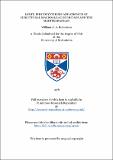Files in this item
Light, photosynthesis and growth of sublittoral macroalgae in Britain and the Mediterranean
Item metadata
| dc.contributor.advisor | Drew, E. A. | |
| dc.contributor.author | Robertson, William A. A. | |
| dc.coverage.spatial | 347 p. | en_US |
| dc.date.accessioned | 2018-06-18T14:51:55Z | |
| dc.date.available | 2018-06-18T14:51:55Z | |
| dc.date.issued | 1976 | |
| dc.identifier.uri | https://hdl.handle.net/10023/14210 | |
| dc.description.abstract | Physiological studies were made of 23 species of red seaweeds (Rhodophyta) and 2 species of green seaweeds (Chlorophyta) in Sicily and at various sites in the British Isles. In Britain, these algae formed part of an "underflora" beneath the canopy of the dominant sublittoral "kelp forest" of Laminaria hyperborea (Phaeophyta). In the Mediterranean, the algae studied formed a turf composed largely of green and red species. In Britain, a standing crop of non-laminarian species of 140g dry weight m-2 was recorded at 5m depth, and approximately half of this at 12m; the crops were about 4 and 12% respectively of the total biomass per m2. At Sicily (Ganzirri, Straits of Messina) a maximum crop of 1360g (dry weight) m-2 was recorded at 15m depth. Radioactive tracer (14C) and dissolved oxygen (Winkler) techniq.ues were developed for use underwater to depths of 60m. Photosynthetic rates measured under agitated incubation conditions were approximately twice the values obtained under static conditions. Rates of photosynthesis measured using the 14C technique were generally high in shallow algae incubated in situ in Britain, e.g. 20 mug C cm-2 h-1 for Porphyra umbilicalis at Om depth; 11 mug C cm-2 h-1 for Rhodymenia palmata, 3m depth. Deeper algae had lower in situ rates, e.g. Delesseria sanguinea, 3.1 mugC cm-2 h-1 and Phycodrys rubens, 1.8 mugC cm-2 h-1, both at 18m depth. At Ganzirri, using the C method, Porphyra umbilicalis attained a rate of 18 mugC cm-2 h-1 at 4.5m and Pseudolithophyllum expansum 4.7 gC cm-2 h-1 at 60m depth. Rates of photosynthesis were strongly reduced by the reduction of irradiance by the water column. Reduction of rates was even more strongly influenced by self-shading in algal stands, Dilsea reaching a photosynthetic efficiency of 8% beneath a L.hyperborea canopy at 4m depth. In general, deep-growing algae were found to be "shade-adapted" (low maximal photosynthetic rates, high-efficiency at low irradiance) and shallow-growing algae were "sun-adapted" but there were notable exceptions. Adaptation occurred within single species. At the deep sites, green algae had photosynthetic rates as high as, or higher than, coexisting red species, suggesting that the red algae had no simple intrinsic photosynthetic advantage conferred by their accessory pigments. Deep specimens of red species exhibited photoinhibition of photosynthesis and photodestruction of pigments when incubated in surface solar irradiance of N 40 J cm-2 PAR. This was noted in such species as Delesseria sanguinea, Phycodrys rubens, Peyssonelia sp., Pseudolithophyllum expansum. Few species studied were below 24-hour compensation point during the summer months and high irradiances of the studies. Few of the deeper algae, however, were operating at or above saturation for any significant length of time. They were thus generally operating at their own maximal efficiencies for most of the time. | en_US |
| dc.language.iso | en | en_US |
| dc.publisher | University of St Andrews | |
| dc.subject.lcc | QK565.R7 | en |
| dc.subject.lcsh | Algae culture | en |
| dc.title | Light, photosynthesis and growth of sublittoral macroalgae in Britain and the Mediterranean | en_US |
| dc.type | Thesis | en_US |
| dc.contributor.sponsor | Science Research Council (Great Britain) | en_US |
| dc.contributor.sponsor | University of St Andrews | en_US |
| dc.type.qualificationlevel | Doctoral | en_US |
| dc.type.qualificationname | PhD Doctor of Philosophy | en_US |
| dc.publisher.institution | The University of St Andrews | en_US |
This item appears in the following Collection(s)
Items in the St Andrews Research Repository are protected by copyright, with all rights reserved, unless otherwise indicated.

